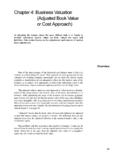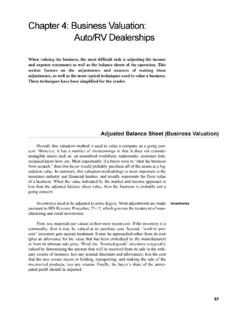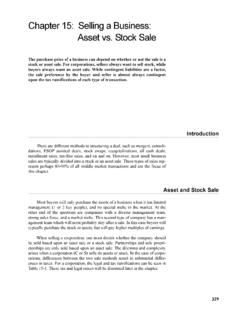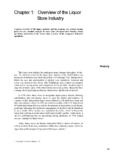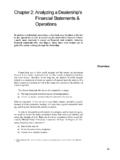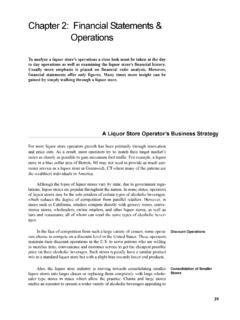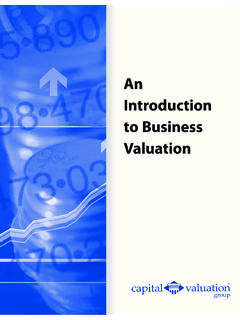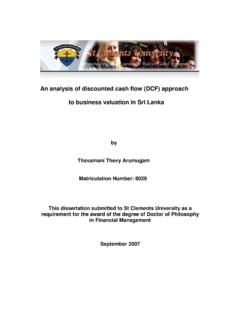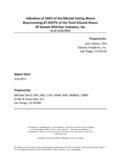Transcription of Chapter 4: Liquor Store Business Valuation - frazier …
1 77 Chapter 4: Liquor Store Business Valuation In this section, we will utilize three approaches to valuing a Liquor Store . These approaches are the: (1) cost (asset based), (2) market, and (3) income approach. The cost approach section focuses on the adjustments and nuances of making balance sheet adjustments, while the market approach values the subject company based on market multiples. Lastly, the income approach will provide a reality check as to the value of the company based on cash Balance Sheet ( Business Valuation )Overall, this Valuation method is used to value a company as a going con-cern.
2 However, it has a number of shortcomings, in that it does not consider intangible assets such as: assembled workforce, trademarks, customer lists, technical know how, etc. Most importantly, if a buyer were to start the Business from scratch, then this buyer would probably purchase all of the assets at a liq-uidation value (see Table 6-2 on page 119). In summary, this Valuation method-ology is most important to the insurance industry and financial lenders and usually represents the floor value of a Business .
3 As an example of an adjusted book methodology, look at Table 4-1 on page 78 and compare the adjusted book value of $248,544 ($175,968 + $5,376 + $67,200) for the total invested capital to the values concluded by the market approach (see Table 4-2 on page 79), and the concluded value of the income approach in Table 4-6 on page 84. It must be noted that not all companies indi-cate such a range in the adjusted balance sheet method, goodwill should also be factored in. Most companies sell for their adjusted book value plus a premium of zero to two times EBITDA.
4 For our subject company, this would result in a premium (goodwill value) of an EBITDA of $39,183 multiplied by to equal an addi-tional $58,774 of value. Total invested capital would equal $307,318 ($175,968 + $5,376 + $67,200 + $58,774) and after subtracting out the $72,576 of interest bearing debt, the equity value would be $234,742 ($175,968 + $58,774 in adjusted goodwill). Liquor License ValueOur subject s Liquor license was purchased recently, and the book value reflects the fair market value of the license.
5 This value reflects the going rate for Liquor Store Business Valuation78such licenses in a quota system and can change from year to year. It is important to contact a broker knowledgeable with Liquor licenses for a given area to obtain an accurate estimate of value. Values vary greatly on projections of demograph-ics, quotas per thousands of people, Business growth trends, and public percep-tion of Liquor stores . It is often the case that developing areas will see higher prices paid for Liquor general idea as to the going rates in various states with quota systems can be seen in Table 2-5 on page 4-1.
6 Sample Adjusted Balance Sheet Book ValueAdjustmentMarket Va l u eAssetsCash & Equivalents$5,384-$5,384 Accounts Receivable 1,200 -1,200 Inventory 94,000 (3,000)91,000 Other Assets---Total Current Assets 100,584 (3,000)97,584 Fixed AssetsMachinery & Equipment 107,000 (42,000)65,000 Market Value of Real Estate---Total Fixed Assets107,000(42,000)65,000 Depreciation (59,250)59,250-Net Fixed Assets 47,750 17,25065,000 Other Assets*135,000-135,000 Total Assets $283,334 $14,250$297,584 LiabilitiesCurrent LiabilitiesAccounts Payable 47,040 2,00049,040 Current Portion Long Term Debt 5,376 -5,376 Other Current Liabilities---Total Current Liabilities 52,416 54,416 Long Term Debt 67,200-67,200 Total Liabilities 119,616 2,000121,616 Stockholder s Equity 163,718 (12,250)
7 175,968 Total Equity & Liabilities $283,334 $14,250$297,584*Other Asset would be the Liquor licenseMarket Approach-Use of Publicly Traded Securities ( Business Valuation )Buyers often use market multiples (from the stock market) to determine a value of a company which they want to value; however, in the case of Liquor Liquor Store Business Valuation79stores, due to varying regulatory measures by each state in the , there are no publicly traded Liquor stores . Because of this, a Valuation based on market com-parables cannot be made, and other methods need to be Valuation of Small Companies ( Business Valuation )As mentioned earlier, this book defines a small Business as one which has sales of less than $10,000,000.
8 Using publicly traded companies is useful, but they are still different from larger capitalized companies. Most large cap compa-nies are publicly traded and therefore bear large 4-2: ODCF MULTIPLESP retax Earnings $22,383 Plus: Depreciation & Amortization11,850 Plus: Interest Expense (Operation Debt net of Real Estate)4,950 Plus: Interest Expense (Real Estate Debt)0 Unadjusted EBITDA39,183 Plus: Owner s Salary20,319 Plus: Actual Rent46,105 Less: Fair Market Rent**(51,840)Owner s Discretionary Cash Flow53,767 Times.
9 Multiplex Value Subtotal166,678 Actual Operating Current Assets100,584 Actual Operating Current Liabilities*(47,040)Plus: Net Working Capital Position53,54453,544 Total Invested Capital220,222 Less: Long Term Debt and Current Portion(72,576)Net Equity Value$147,646 REVENUE MULTIPLESR evenue $350,315 Times: Multiple x Unadjusted Value 136,623 Plus: Net Working Capital Position53,54453,544 Total Invested Capital190,167 Less: Long Term Debt and Current Portion(72,576)Net Equity Value$117,591* Current liabilities do not include current portion of long term debt.
10 Financials are taken from Table 2-3 on page 43 and Table 2-4 on page 44.**Rent was determined by actual rent at the time of Valuation (see Table 5-14 on page 103 and Table 5-19 on page 107).Subject Company ODCF CalculationsLiquor Store Business Valuation80As the value of a company approaches the lower end of the range, sales from $0-$10,000,000, the multiples from publicly traded companies become less important to buyers. In summary, publicly traded companies have less risk, greater access to capital markets, and an overall better ability to survive as a going concern.
